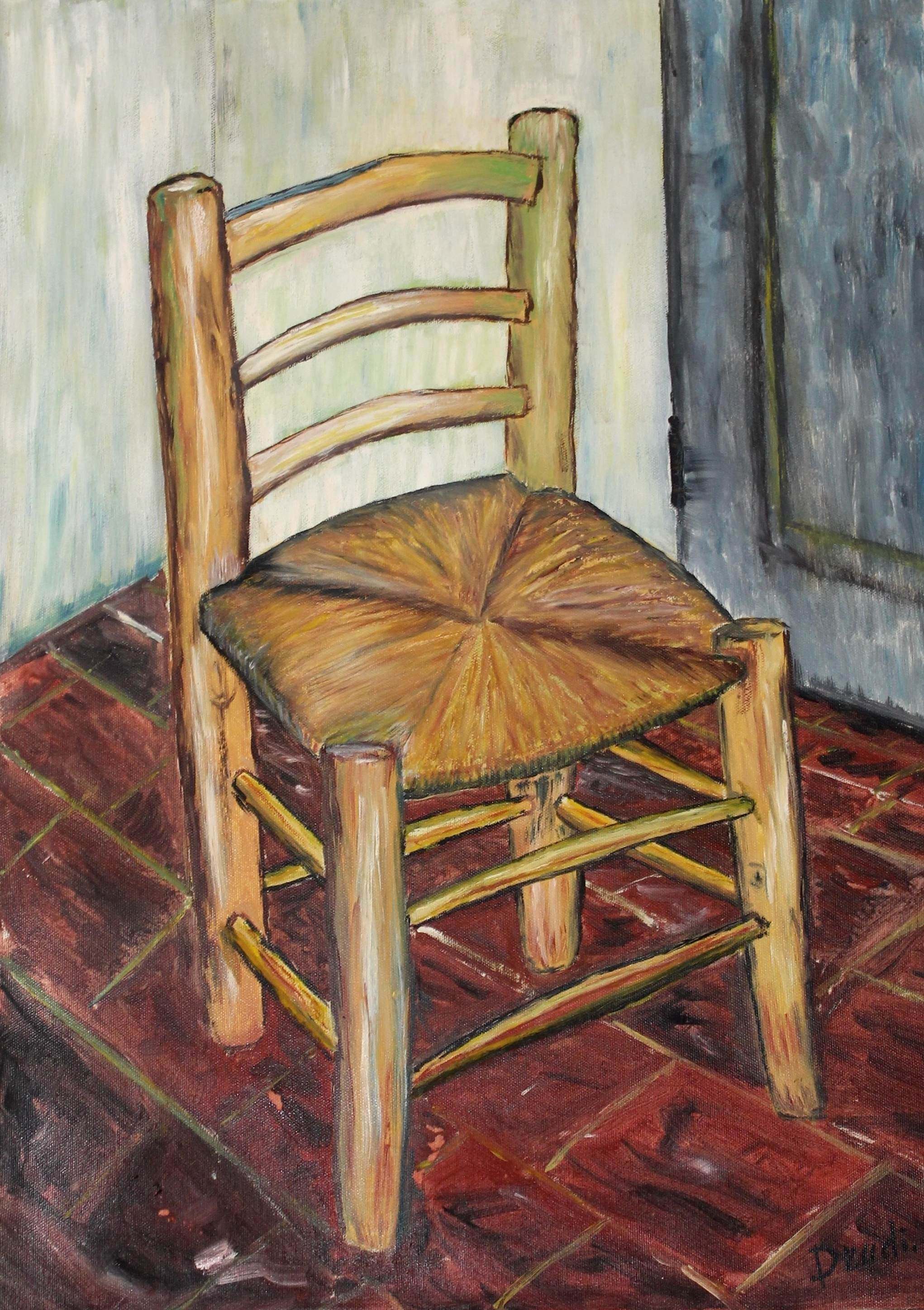THE CHAIR
1978, 50x70cm, Bright oil on canvas

A simple wooden chair with a woven straw seat, the absolute protagonist of a domestic interior, in a style reminiscent of Vincent van Gogh’s famous painting.
The work depicts a simple rustic wooden chair with a woven straw seat, positioned in the corner of a room. The chair has an essential structure with three horizontal bars forming the backrest and rests on a terracotta floor in reddish tones, arranged in a diagonal pattern. The walls of the room present contrasting colors: the one on the left is of a light tone, tending towards beige-yellowish with greenish shades, while the one on the right is a darker and more intense blue-gray. The composition is deliberately simple, creating an atmosphere of solitude and everyday life, where the ordinary object becomes the protagonist and assumes a symbolic value, almost a portrait of human absence.
Painting technique:
The work is created with oil on canvas. The technique is characterized by visible and textured brushstrokes that build the form through layers of color. The artist has used a relatively limited but expressive palette, dominated by warm tones for the chair (ochre, browns, yellows) that contrast with the cooler and more neutral tones of the walls. The texture of the straw seat is rendered with radial brushstrokes starting from the center, creating an effect of movement. The terracotta floor is painted with decisive and directional brushstrokes that highlight its diagonal arrangement. The light in the work seems to come from the left, creating subtle shadows and giving depth to the scene without dramatic chiaroscuro contrasts.
Similarity to Van Gogh’s painting:
This work presents evident stylistic and thematic references to the art of Vincent van Gogh, in particular to his famous series of chairs (such as “Vincent’s Chair” from 1888). The similarities include:
- The choice of an everyday subject elevated to the protagonist of the canvas
- The use of visible and directional brushstrokes that build the form
- The slightly distorted perspective that increases expressiveness
- The chromatic contrasts between complementary colors (blue-orange)
- The emotional rather than purely descriptive approach to the object
As in Van Gogh, here too the chair seems to take on an almost anthropomorphic dimension, becoming a presence that evokes human absence. The rigorous composition but emotional rendering of the subject recalls the approach of the Dutch master, who saw in everyday objects a reflection of the human condition and an opportunity to explore the expressive potential of color and pictorial matter.

A simple wooden chair with a woven straw seat, the absolute protagonist of a domestic interior, in a style reminiscent of Vincent van Gogh’s famous painting.
The work depicts a simple rustic wooden chair with a woven straw seat, positioned in the corner of a room. The chair has an essential structure with three horizontal bars forming the backrest and rests on a terracotta floor in reddish tones, arranged in a diagonal pattern. The walls of the room present contrasting colors: the one on the left is of a light tone, tending towards beige-yellowish with greenish shades, while the one on the right is a darker and more intense blue-gray. The composition is deliberately simple, creating an atmosphere of solitude and everyday life, where the ordinary object becomes the protagonist and assumes a symbolic value, almost a portrait of human absence.
Painting technique:
The work is created with oil on canvas. The technique is characterized by visible and textured brushstrokes that build the form through layers of color. The artist has used a relatively limited but expressive palette, dominated by warm tones for the chair (ochre, browns, yellows) that contrast with the cooler and more neutral tones of the walls. The texture of the straw seat is rendered with radial brushstrokes starting from the center, creating an effect of movement. The terracotta floor is painted with decisive and directional brushstrokes that highlight its diagonal arrangement. The light in the work seems to come from the left, creating subtle shadows and giving depth to the scene without dramatic chiaroscuro contrasts.
Similarity to Van Gogh’s painting:
This work presents evident stylistic and thematic references to the art of Vincent van Gogh, in particular to his famous series of chairs (such as “Vincent’s Chair” from 1888). The similarities include:
- The choice of an everyday subject elevated to the protagonist of the canvas
- The use of visible and directional brushstrokes that build the form
- The slightly distorted perspective that increases expressiveness
- The chromatic contrasts between complementary colors (blue-orange)
- The emotional rather than purely descriptive approach to the object
As in Van Gogh, here too the chair seems to take on an almost anthropomorphic dimension, becoming a presence that evokes human absence. The rigorous composition but emotional rendering of the subject recalls the approach of the Dutch master, who saw in everyday objects a reflection of the human condition and an opportunity to explore the expressive potential of color and pictorial matter.